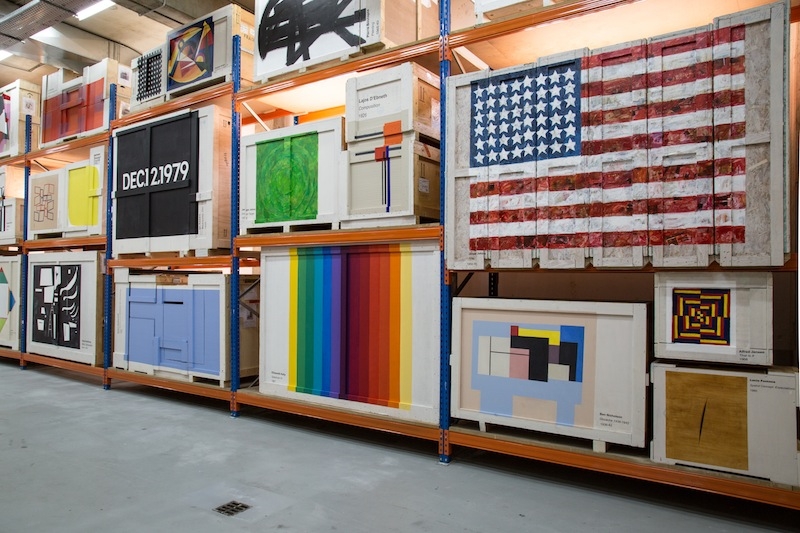Have you ever heard of a world that exists between the natural and the spiritual worlds? One that mediates between sensory reality and the mystical realm of the divine? This intermediate world welcomes imaginative consciousness and allows cognitive imagination to thrive. It is the world of the image, the faculty of perception and of vision; it is the place where imaginative power is at home. No wonder I learn about it from artist Walid Raad and that I keep pondering it as I make a pilgrimage to the Beirut storage space of collector Tony Salamé to see what’s described as Raad’s collaboration with Suha Traboulsi, a work titled Postscript to the Arabic translation and featuring paintings on the sides of storage crates.
Rather than fantasy producing ‘the imaginary’, which can be limiting in its insistence on the ‘unreal’, the ‘imaginal’ is analogue to the perceptible, normal world around us but not immediately noticeable to the senses, like a mirror reflecting something without itself partaking in the physical properties of that which is reflected. Does this imaginal world sound muffled and a bit esoteric? It is what theosophers of Islam, specifically Persian mystics, have called ‘mundus imaginalis’.
I come across the imaginal in conversation with Raad while trying to figure out how to describe art’s capacity to say something about the future without ending up in futurology, science fiction, techno pessimism, pep-talk utopianism and the other usual stuff. I am searching for a term that accounts for pre-figuration, diagnosis and prognosis, and allows for a slightly different, be it ambiguous and conflictual, perspective on how art engages with what lies ahead of us.
Raad mentions the late Islam scholar Henri Corbin and his 1964 text ‘Mundus Imaginalis, or the Imaginary and the Imaginal’. Corbin contends that the imaginal is far from unreal or nonexistent; instead it establishes real imaginative knowledge and function. And yet it is escaping rationalism as we know it. It is not based on a separation of matter and spirit, history and myth, because the ‘where’ – a concrete location – resides in the soul, and the corporeal exists in the spiritual. In fact, the soul encloses and carries the body; the spiritual place is not situated but that which situates. Such active imagination equals a transmutation of internal spiritual states into external ones. It is ontologically real but beyond our ordinary way of perceiving and understanding things. In other words, it is visionary knowledge.
In November, during Ashkal Alwan’s seventh edition of Home Works, the multidisciplinary forum on cultural practices held every two or three years at the Lebanese nonprofit organisation, I visit Beirut’s new art-kid-on-the-block: Salamé’s Aïshti Foundation, an exhibition space in the high-end shopping mall he’s just opened, designed by David Adjaye. The generic, strikingly unimaginative collection’s perversion is enhanced by the setting, with glass doors between shops and the exhibition space: both devoid of people during my visit. Not only is this amassing of artwork utterly boring for being so standard, it looks like an imported shopping cart for art, albeit the kind of art previously not seen in public in Lebanon. This guy has access to one of the most interesting art communities and regions in the world, and yet he appears to focus on the kind of bland trophy art that a certain part of the Western circuit hails. On top of that, while backing mainstream institutions in NYC, he allegedly refrains from supporting the local art-scene, which urgently needs precisely that. His seems to be a base world far away from the imaginal.
Agreeing to loan a work to the collector, Raad made a context-sensitive work for him, consisting of paintings on the sides of crates in Salamé’s storage space in a suburb of Beirut, where they will be for the next three years. The story goes like this: between 1952 and 1974 the Lebanese government collected national and international paintings for a future museum. However, political figures and their spouses snuck some of the paintings away from storage belonging to the ministry of culture, and they eventually ended up at MOMA in New York. Unable to stop this trickling, Suha Traboulsi, the collection’s registrar, painted replicas of lost paintings by, among others, Kazimir Malevich, Sophie Taeuber-Arp, Hélio Oiticica and Ellsworth Kelly on the crates in storage.
This is smart, cheeky and imaginal institutional critique of the commercial art sector. In a funny way, Raad’s story is the reverse of Salamé’s: once upon a time there was a fantastic collection of abstract paintings in Lebanon, which in Mondrian’s sense use abstraction to intensify rather than simplify, and which through corruption leave the country bit by bit and end up at MOMA, where they are shown piecemeal. Today, diluted works from numerous New York galleries have found their way to Beirut, where they are presented in an inflated manner. However, in both cases the local dimension of art is missing. It leaves me wondering who the keepers of Salamé’s collection are and what Raad will eventually do with the crates once they return to him.
This article first featured in ArtReview Asia Volume 4 Issue 1
